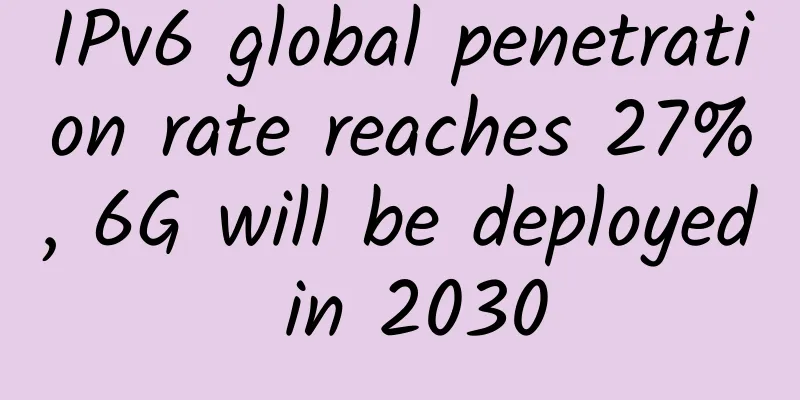IPv6 global penetration rate reaches 27%, 6G will be deployed in 2030

|
Recently, Latif Ladid, chairman of the National IPv6 Forum, mentioned in a public speech that the global penetration rate of IPv6 has reached 27%, and China's IPv6 Internet users have exceeded 200 million. At the same time, he mentioned that the world has also begun to study 6G. The IPv6 protocol has been highly promoted in recent years. With the popularization of the Internet and the impact of artificial intelligence technology on online and offline development, the number of IPv4 addresses is no longer sufficient, which has become a problem that troubles countries. Therefore, the upgrade of the IP protocol has become more and more urgent. Compared with IPv4, the 128-bit IP address length in IPv6 will increase 340 trillion IP addresses, which can basically meet the needs of the future Internet world where everything is connected. Latif Ladid pointed out that India and China will be the largest user markets for IPv6. In terms of user scale, India is the largest with 250 million users, while China already has more than 200 million IPv6 Internet users. It is understood that China's Alibaba Cloud and Tencent Cloud already support IPv6 services, and many products under Alibaba and Tencent already fully support IPv6, such as QQ, Taobao, etc. Data shows that as of the end of March 2019, countries or regions with a global comprehensive IPv6 deployment rate of around 30% or above accounted for more than half of the map area, and the proportion of users using IPv6 to access Google's network has exceeded 27% of the total number of users, indicating that the IPv6 ecosystem is taking shape. Liu Dong, director of the National Engineering Center for Next Generation Internet, also said that China will comprehensively upgrade IPv6 at the national level and use 5-10 years to build the world's largest IPv6 commercial network to realize the interconnection of all things. At the same time, the deployment of global 5G networks also requires the continued advancement of IPv6. Latif Ladid said that in addition to 5G, many countries are currently researching 6G, which can reach a speed of 100G/s and is expected to be deployed around 2030. |
<<: 10 ways to improve Wi-Fi signal when surfing the Internet
>>: Why are 5G chips so expensive?
Recommend
[Black Friday] RAKsmart top up $10 and get $10/top up $50 and get $30/top up $100 and get $50, VPS hosting starts from $0.99/month, cloud server starts from $2.49/month
RAKsmart Black Friday special offer is here, new ...
RAKsmart: 5+253 IP cluster servers starting at $177 per month, with data centers in Los Angeles/San Jose/Japan/Hong Kong available
Earlier this month, we shared the popular cloud s...
Wi-Fi 6 and cellular networks are powering a hyperconnected future
Wi-Fi 6 is maturing into a new role as a compleme...
[11.11]RAKsmart: US servers start from $30/month, Japan/Korea servers start from $59/month, cluster servers start from $109/month
A few days ago, we shared RAKsmart's recharge...
BandwagonHost: CN2 GIA special price replenishment starting from $83.8/year, 2GB/40G SSD/[email protected]/multiple nodes optional
[Updated on February 27, 2024] Bandwagonhost has ...
Wi-Fi 7 is on the way, is there a market for Wi-Fi 6E in China?
On January 7, US time, the Wi-Fi Alliance launche...
Why is your broadband speed never as fast as your operator says?
According to some users, in order to improve the ...
Should I turn off my router when I go to bed at night? This is a question
Nowadays, many people have WiFi at home and have ...
Traditional SMS is rising against the trend with the help of 5G. What do you think?
In recent years, it seems that it has become a fa...
The first half of the year for the three major operators ended: the number of 5G package users approached 500 million and the penetration rate exceeded 30%
[[412357]] Yesterday, the three major operators r...
How do 5G base stations control mobile phones under NSA?
The 5G network architecture is divided into SA an...
Discussion on SD-WAN development: SD-WAN combined with blockchain technology
As software-defined wide area networks (SD-WAN) b...
How to solve edge bottlenecks caused by the surge in data usage
The importance of data is changing today, and the...
Canceling traffic "roaming": Will there be 93 operators in China?
At the first session of the 13th National People&...
RackNerd: Cheap VPS starting at $10 per year, multiple data centers in San Jose/Los Angeles/Seattle/New York/Dallas, etc.
This weekend, we will share the cheap VPS package...









